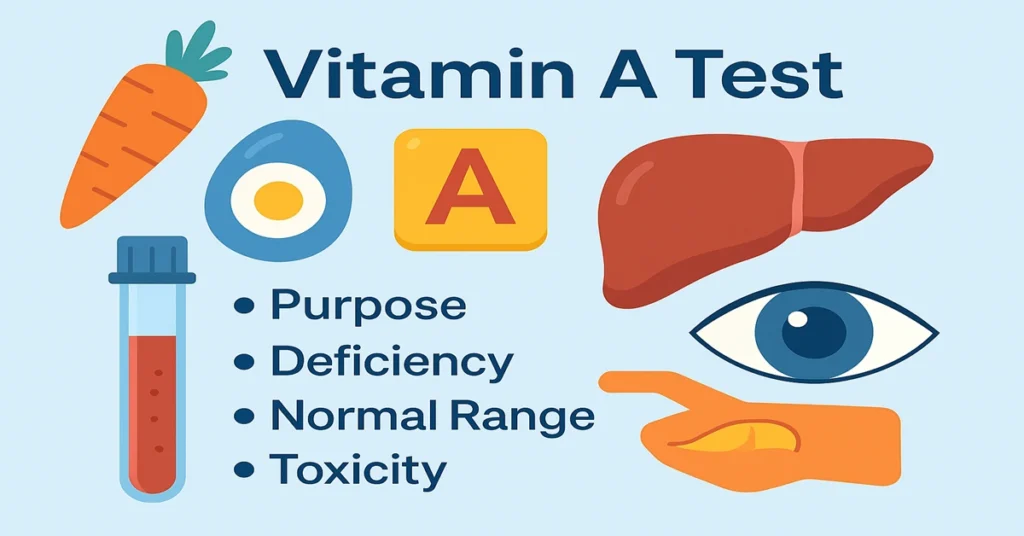What is the Vitamin A Test?
The Vitamin A test measures the amount of Vitamin A (Retinol) present in your blood.
Vitamin A is a fat-soluble vitamin that is essential for maintaining healthy vision, skin, immune system, and proper cell growth.
This test is useful to detect Vitamin A deficiency or Vitamin A toxicity (overdose).
Both low and high levels can lead to health problems — from vision issues and weak immunity to liver and bone disorders.
Doctors often recommend this test when symptoms of night blindness, dry skin, or frequent infections appear.
How is Vitamin A Produced or Stored in the Body?
Unlike some vitamins, Vitamin A is not produced by the human body.
It is obtained through your diet from two main sources:
- Animal sources (Retinol – active form): Liver, eggs, dairy products, fish oil.
- Plant sources (Beta-carotene – converted into Vitamin A inside the body): Carrots, spinach, sweet potatoes, pumpkin, papaya, etc.
After being absorbed in the small intestine, around 80–90% of Vitamin A is stored in the liver.
The liver then releases it into the blood when needed for normal body functions.
Main Functions and Importance of Vitamin A
Vitamin A plays many vital roles in maintaining health and development. Its main functions include:
- Vision (especially night vision):
Helps maintain the retina and prevents night blindness. - Immune system support:
Improves the ability of white blood cells to fight infections. - Skin and mucous membrane protection:
Keeps the skin, lungs, intestines, and other tissues healthy. - Cell growth and reproduction:
Supports fetal development, growth in children, and tissue repair. - Antioxidant property:
Beta-carotene form of Vitamin A helps neutralize free radicals and reduces oxidative stress.
Causes of Low Vitamin A (Deficiency)
A deficiency of Vitamin A can occur when your body doesn’t get enough from food or can’t absorb it properly.
Common causes include:
- Poor or unbalanced diet (especially in children and undernourished adults)
- Fat absorption disorders (Celiac disease, cystic fibrosis, pancreatitis)
- Liver disorders (as liver stores Vitamin A)
- Long-term diarrhea or infections
- Alcoholism (reduces absorption and liver function)
- Fever or chronic illnesses that increase body demand
Symptoms of Vitamin A Deficiency
When Vitamin A levels are too low, the following symptoms can appear:
- Night blindness – difficulty seeing in dim light (early and common sign)
- Dry eyes and corneal ulcers (xerophthalmia)
- Dry, rough, or scaly skin
- Frequent infections – especially respiratory or skin infections
- Fatigue and weakness
- Delayed growth in children
- Reproductive problems (in severe deficiency)
If untreated, Vitamin A deficiency can lead to permanent blindness or severe immune weakness.
Causes of High Vitamin A (Toxicity)
High levels of Vitamin A, known as Vitamin A toxicity (Hypervitaminosis A), usually occur due to excessive supplement intake or retinoid medications.
Common causes:
- Overuse of Vitamin A supplements without medical advice
- Long-term use of retinoid medicines (used in acne or skin treatments)
- Frequent consumption of animal liver (very high in Vitamin A)
- Accidental overdose in children
Symptoms of Vitamin A Toxicity
Vitamin A toxicity can be acute (sudden) or chronic (long-term).
Acute Toxicity (after large dose):
- Nausea or vomiting
- Dizziness
- Headache
- Blurred vision
Chronic Toxicity (long-term overdose):
- Liver damage or enlargement
- Bone and joint pain
- Hair loss
- Dry, cracked lips and skin
- Fatigue and irritability
- Birth defects if overdose occurs during pregnancy
Important: Never take high-dose Vitamin A supplements without a doctor’s prescription.
Reference Ranges (Normal Vitamin A Levels)
Normal range may vary by laboratory.
Typical reference values are:
- Adults: 28 – 86 µg/dL (micrograms per deciliter)
- Children: Slightly lower; varies by lab.
⚠️ Always interpret the result with your doctor, keeping your symptoms and diet in mind.
Sample Type and Test Method
- Sample type: Serum (blood sample)
- Collection tube: Red-top (plain) tube
- Fasting: Usually 8–12 hours fasting may be advised before the test
- Processing: Sample analyzed using high-performance liquid chromatography (HPLC) for accurate Vitamin A measurement.
How to Maintain Healthy Vitamin A Levels
Include Vitamin A–rich foods:
- Animal sources: Eggs, milk, cheese, fish liver oil, liver.
- Plant sources (Beta-carotene): Carrots, pumpkins, spinach, kale, sweet potatoes, mangoes.
Avoid Overdose:
- Take supplements only under medical supervision.
- Avoid daily consumption of liver or high-dose retinoids.
- Pregnant women should be extra cautious to prevent fetal toxicity.
Test Preparation
- Fasting: You may be asked to fast for 8–12 hours before the test.
- Avoid supplements: Stop Vitamin A or multivitamin supplements at least 24–48 hours before testing (consult your doctor first).
- Inform doctor: If you are on retinoid medicines or liver-related treatments.
- Sample type: Blood sample collected from a vein.
When to Consult a Doctor
You should consult your doctor if you notice:
- Difficulty seeing in low light (night blindness)
- Persistent dry eyes or rough skin
- Frequent infections or slow healing wounds
- Signs of Vitamin A overdose (nausea, headache, liver pain, fatigue)
- You are taking Vitamin A supplements for a long time
Early diagnosis and proper dosage correction can prevent serious complications like vision loss or liver toxicity.
Important Word Explanations
| Word | Meaning |
|---|---|
| Retinol | Active form of Vitamin A found in animal foods |
| Beta-carotene | Precursor of Vitamin A found in plants, converted to retinol in the body |
| Fat-soluble vitamin | Stored in body fat and liver instead of being excreted daily |
| Xerophthalmia | Severe dryness of the eyes due to Vitamin A deficiency |
| Hypervitaminosis A | Condition caused by excessive Vitamin A intake |
| HPLC | Laboratory technique used to measure Vitamin A accurately |
~END~

